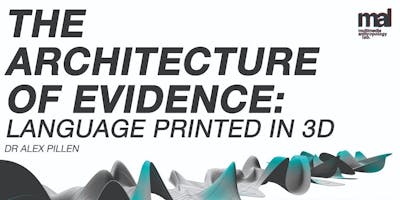You must login before you can post a comment.
Friday 18 October 18:00 - 20:00
University College London, Anthropology Department
14 Taviton Street
King's Cross
London
WC1H 0BW
Registration
- 🍻
The Architecture of Evidence: Language Printed in 3D | MAL Seminars
Other
The architecture of evidence: language printed in 3D | MAL seminars with Dr Alex Pillen (UCL)
Friday 18th October | 6-8pm | DFSR | UCL Anthropology
Join the UCL Multimedia Anthropology Postgraduate Lab: Research and Reading Group on Friday 18th of October for a unique seminar by Dr Alex Pillen (Associate Professor, UCL Anthropology). Alex will present her recent experimental work on language, in collaboration with the Bartlett School of Architecture, where words are 3D printed as objects. The seminar will be accompanied by an exhibition of some of the objects Alex has been printing. A drinks reception will be provided.
We are especially excited about this event as Alex is a senior anthropologist at our home UCL anthropology department. Her theoretical rigour, combined with the experimental approach to her subject matter, is exemplary of the kind of research that inspired the MAL initiative, and Alex has actively supported our project from the very beginning.
This event has been made possible by generous support from the UCL Anthropology Department.
The architecture of evidence: language printed in 3D
All languages have the means for establishing ‘evidence’ for what one is saying. Evidentiality constitutes sections of verbal performance which are closely tied into observable reality. Language and perceivable reality are woven into a fabric, its shape depending on the grammar of each language.
We used spline-based computation as such a virtual place to explore the architecture of evidence in language. An anthropology of sound and experimental architecture enables a portrayal of language as a frozen, abstracted, syllabic, or sonic structure woven into reality by means of evidentiality. We present a method of visualisation in 3D of the architecture of evidence across languages. The latest 3D modelling tools allowed us to digitally construct prototypes based on an Amazonian language, Kurdish, the ancient Neo-Assyrian language and American English. The images are based on a translation into a visual programming language, and graphical algorithm editor (Grasshopper integrated with Rhino's 3-D modelling tools). The comparative nature of this study’s images is intended as a visual analysis of linguistic modernity and the erosion of contextual evidence.
The images created for this study define a new typology of representation of language; one which is between the analytical and figurative and encourages the viewer to understand the nuances of each of these worlds simultaneously. Such a CAD ‘surface’ is not conceived as a linguistic trace superimposed upon reality, but a weft of language threaded through it, as an all-enveloping infusion. Reality rather than being a solid globe upon the surface of which language unfolds appears textile. The tensile strength of its linguistic threads and overall shape defined by the evidential resources of each language. These images are both communicative and inquisitive. Their form was uncertain until they were created, at which point they revealed previously unvisualised relationships between language and the axis of observable reality.




